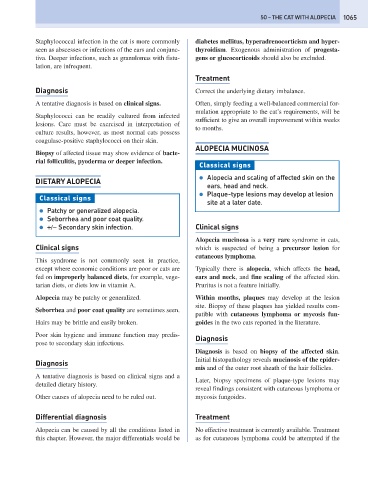Page 1073 - Problem-Based Feline Medicine
P. 1073
50 – THE CAT WITH ALOPECIA 1065
Staphylococcal infection in the cat is more commonly diabetes mellitus, hyperadrenocorticism and hyper-
seen as abscesses or infections of the ears and conjunc- thyroidism. Exogenous administration of progesta-
tiva. Deeper infections, such as granulomas with fistu- gens or glucocorticoids should also be excluded.
lation, are infrequent.
Treatment
Diagnosis Correct the underlying dietary imbalance.
A tentative diagnosis is based on clinical signs. Often, simply feeding a well-balanced commercial for-
mulation appropriate to the cat’s requirements, will be
Staphylococci can be readily cultured from infected
sufficient to give an overall improvement within weeks
lesions. Care must be exercised in interpretation of
to months.
culture results, however, as most normal cats possess
coagulase-positive staphylococci on their skin.
ALOPECIA MUCINOSA
Biopsy of affected tissue may show evidence of bacte-
rial folliculitis, pyoderma or deeper infection.
Classical signs
● Alopecia and scaling of affected skin on the
DIETARY ALOPECIA
ears, head and neck.
● Plaque-type lesions may develop at lesion
Classical signs
site at a later date.
● Patchy or generalized alopecia.
● Seborrhea and poor coat quality.
● +/- Secondary skin infection. Clinical signs
Alopecia mucinosa is a very rare syndrome in cats,
Clinical signs which is suspected of being a precursor lesion for
cutaneous lymphoma.
This syndrome is not commonly seen in practice,
except where economic conditions are poor or cats are Typically there is alopecia, which affects the head,
fed on improperly balanced diets, for example, vege- ears and neck, and fine scaling of the affected skin.
tarian diets, or diets low in vitamin A. Pruritus is not a feature initially.
Alopecia may be patchy or generalized. Within months, plaques may develop at the lesion
site. Biopsy of these plaques has yielded results com-
Seborrhea and poor coat quality are sometimes seen.
patible with cutaneous lymphoma or mycosis fun-
Hairs may be brittle and easily broken. goides in the two cats reported in the literature.
Poor skin hygiene and immune function may predis-
Diagnosis
pose to secondary skin infections.
Diagnosis is based on biopsy of the affected skin.
Initial histopathology reveals mucinosis of the epider-
Diagnosis
mis and of the outer root sheath of the hair follicles.
A tentative diagnosis is based on clinical signs and a
Later, biopsy specimens of plaque-type lesions may
detailed dietary history.
reveal findings consistent with cutaneous lymphoma or
Other causes of alopecia need to be ruled out. mycosis fungoides.
Differential diagnosis Treatment
Alopecia can be caused by all the conditions listed in No effective treatment is currently available. Treatment
this chapter. However, the major differentials would be as for cutaneous lymphoma could be attempted if the

